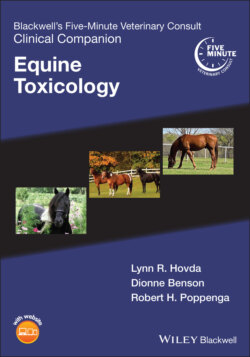Читать книгу Blackwell's Five-Minute Veterinary Consult Clinical Companion - Группа авторов - Страница 68
ОглавлениеChapter 11 Methamphetamine/ Amphetamine
DEFINITION/OVERVIEW
There is no label indication for these compounds in veterinary medicine and exposure is most commonly due to inadvertent exposure.
Neuroexcitation, agitation, tachycardia, hypertension, and tachypnea are the most common clinical signs noted in the case of toxicity.
ETIOLOGY/PATHOPHYSIOLOGY
Mechanism of Action
Stimulates the release of monoamine neurotransmitters (dopamine, serotonin, and norepinephrine) from nerve endings.
Inhibits reuptake and metabolism of catecholamines, increasing amount at nerve endings.
Toxicokinetics
Pharmacokinetics of methamphetamine have been described in horses.
Absorption, T max: 15–30 minutes following transmucosal exposure.
Distribution, V ss: 4.44 ± 0.648 L/kg
Metabolism: amphetamine is a minor metabolite of methamphetamine.
Both methamphetamine and amphetamine (at lesser concentrations) are found in urine.
Terminal half‐life: 0.5–1.7 hours
Urinary alkalization in humans prolongs drug elimination. In horses, urine pH does not appear to affect elimination (10 mg methamphetamine exposure).
Toxicity
Amphetamine:LD50 in rats and mice is 10–30 mg/kg.
Methamphetamine:LD50 (oral) in dogs is 9–11 mg/kg.Ingestion of 1.3 mg/kg in humans – death.
Systems Affected
Nervous – agitation, ataxia.
Cardiovascular – tachycardia, hypertension.
Respiratory – tachypnea.
SIGNALMENT/HISTORY
Historical Findings
History of exposure and clinical signs.
Location and Circumstances of Poisoning
Most likely exposure is from environment including inadvertent by animal handler.
CLINICAL FEATURES
Clinical signs include hyperactivity, tremors, ataxia, tachycardia, hypertension, hyperthermia, bilaterally dilated pupils, aggression, and circling.
Severe abdominal pain, bloody diarrhea, and gut ischemia have been reported in humans following ingestion.
DIFFERENTIAL DIAGNOSIS
CNS stimulants – cocaine, ephedrine, pseudoephedrine, methylxanthines, strychnine.
DIAGNOSTICS
History of exposure and clinical signs.
Thrombocytopenia, prolonged PT and activated PTT (consistent with disseminated intravascular coagulation) reported in dogs and humans.
Quantitation of methamphetamine or amphetamine in urine.Drug screening kits available, however, not currently validated for horses.
LC‐MS can assist with diagnostics but may not be timely for therapy.
THERAPEUTICS
The overall goal is to provide supportive care and allow the animal to clear the drug.
Detoxification
Urinary acidification with ammonium chloride or ascorbic acid has been suggested to increase the rate of elimination in some species. If this is attempted, acid–base status should be monitored. In horses, urinary acidification did not enhance elimination following transdermal administration of 10 mg.
Appropriate Health Care
Monitor closely to ensure animal does not injure itself due to neuroexcitation.
Monitor blood pressure, heart rate and rhythm and respiration.
Monitor temperature.
Antidotes
None available.
Drugs of Choice
Phenothiazines tranquilizers to control CNS signs:Animal should be monitored as seizure threshold may be lowered.Acepromazine (0.05–1 mg/kg IV).
Diazepam and other barbiturates – for seizure activity.
Propranolol for tachycardia (0.02–0.06 mg/kg IV).
COMMENTS
Client Education
Ensure animal will not be exposed in the future.
Contact veterinarian if clinical signs return or worsen.
Patient Monitoring
▪ Behavioral monitoring.
Monitor heart rate and blood pressure.
ECG as needed.
Monitor electrolytes.
Prevention/Avoidance
Prevent inadvertent exposure by handlers.
Possible Complications
Self‐injury due to excitation/ataxia.
Death.
Expected Course and Prognosis
Time to development of clinical signs likely within 15–30 minutes but will vary with degree of exposure and amount exposed to.
Prognosis depends on severity of poisoning.
Abbreviations
See Appendix 1 for a complete list.
Suggested Reading
1 Knych HK, Arthur RM, Kanarr KL, et al. Detection, pharmacokinetics and selected pharmacodynamic effects of methamphetamine following a single transmucosal and intravenous administration to exercised thoroughbred horses. Drug Test Anal 2019; 11:1431.
2 Zengyang P, Zhang X. Methamphetamine intoxication in a dog: case report. BMC Veterinary Research 2014; 10:139.
Author(s): Heather K. Knych DVM, PhD, DACVCP
Consulting Editor: Dionne Benson, DVM, JD
